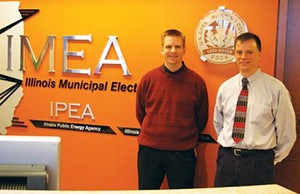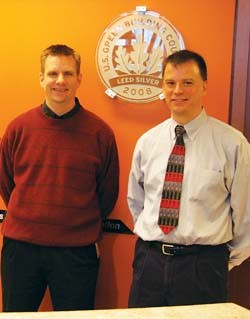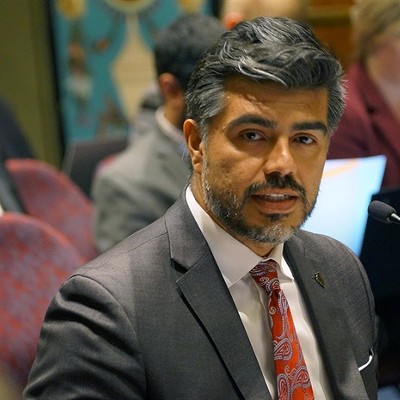
As Erin’s Pavilion at Southwind Park approaches completion and its Leadership in Energy and Environmental Design (LEED) designation, it follows the path cleared by another notable Springfield “green” design.
Last month the new Illinois Municipal Electric Agency headquarters, located at 3400 Conifer Dr., was awarded LEED silver level certification by the United States Green Building Council for its achievement in sustainable site development, water savings, energy efficiency, materials selection and indoor environmental quality. The west-side facility became Springfield’s first to receive recognition from the USGBC, an organization that promotes renewable-energy efforts in new construction.
T. David Parker, the principal and project architect from Springfield’s Melotte Morse Leonatti Parker, Ltd., says the IMEA found a significant advantage to going green with the 33,000-square-foot, Frank Lloyd Wright-inspired building. Since the organization competes with other utility providers like Ameren and the Commonwealth Edison Company, its owners wanted a building that highlights their position in both the power market and the environment.
“It’s about putting your best foot forward to potential customers,” Glenn Cunningham, IMEA manager of systems development and member of the
building committee, says. “We wanted a showplace to show where we think we stand.”
“And as an energy provider, the idea of going green was really effective — to lead by example,” Parker adds.
The IMEA began its efforts in the construction phase by recycling more than 50 percent of leftover materials such as bricks, steel, and cardboard. Its three-story building was crafted with a well-insulated exterior envelope – rating 16 percent more efficient than code.
Office space was constructed on the building’s exterior to take advantage of window day lighting. Large “portholes” that collect daylight from openings in the roof and transfer it throughout the
building were also installed, along with indirect fluorescent fixtures. Light
sensors monitor the incoming daylight and adjust the fluorescent lights
accordingly; motion sensors monitor the number of people in each room and
adjust light levels accordingly.
“It’s much healthier for people,” Parker says. “Part of being green is creating a healthier environment.”
More than 20 percent of the building was constructed with recycled materials, and another 20 percent was reaped or manufactured within 500 miles of Springfield. Even office furniture has a green aspect to it, Cunningham says — the wood comes from forestry operations that pledge to replant what they harvest.
Cunningham explains that special care was taken in the operations room, where the organization houses its computers and servers. Normally these types of rooms are kept at a cool temperature, he says, because its easy for servers to become overheated. The IMEA took a different approach by installing a multi-stack chiller for computer server cooling.
“We found a very cool solution to this that has an eco-side to it as well,” Cunningham says. “We have air conditioners that are built into the racks. The air conditioner is sucking out heat directly from the source and immediately returning it to the front.
“We just condition this space right here.”
A geothermal system heats and cools the building. Ten miles of pipe was constructed under the main parking lot so that heat could be pulled into the building during the winter and transferred from the building during the summer. IMEA expects to save $6,100 annually by using this method over a conventional electric boiler system.
Parker says more savings will come from the energy recovery ventilators, a technology that picks up heat and humidity from incoming air and transfers it into the outgoing air stream. This relieves the burden on the heating and cooling system by eliminating drastic temperature changes.
IMEA also made efficiency efforts outside of its building. Native species comprise most of the landscaping so that only rain is needed for maintenance. The organization collects storm water on-site, routes it to a detention pond, and then returns it to the aquifer to aid its wastewater process. Additionally, Parker says, the parking spaces nearest the building are reserved for carpool and alternative fuel vehicles to encourage employees to go green.
Parker, whose firm has also worked on a separate LEED project in Danville, says the IMEA building came together because its owners desired to try something new and better. There’s a strong business case to going green, he adds, since most environmental elements cut costs over time.
“When most people go out to build a building, they’re looking for the lowest cost possible during construction,” Cunningham agrees. “But they’re forgetting about the long-term cost of owning and operating the building.
“The geothermal system in this building will pay for itself in five, seven years.
Everything after that is a savings.”
IMEA tours are available by appointment. For more information, visit
www.imea.org.
Contact Amanda Robert at [email protected]
















